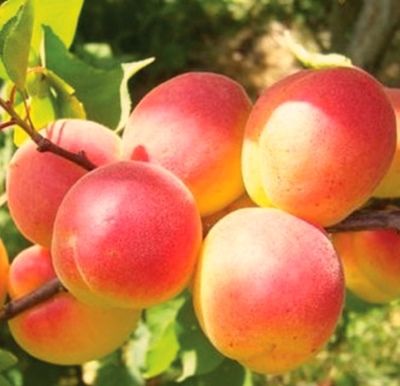
- Authors: America
- Name synonyms: NZHA-19
- Fruit weight, g: 90-170
- Fruit shape: spherical
- Skin : slightly pubescent
- Fruit color: yellow-orange, with a delicate reddish blush on the sunny side
- Pulp color : light yellow
- Pulp (consistency): dense, not fibrous, juicy
- Fruit taste: sweet, with a honey aftertaste and slight sourness
- Separability of the bone from the pulp: good
Apricot NJA-19 (НЖА-19), also known as New Jersey American, is very popular in the southern regions of Russia and Ukraine, as well as in its homeland, the United States. Excellent taste makes its fruit an excellent choice for fresh consumption. Even ripe apricots can easily tolerate storage and transportation, have an aesthetic presentation, while reaching record sizes, almost the size of a peach.
Breeding history
A variety of American selection. Bred in 1971 in the state of New Jersey.
Description of the variety
The trees are medium-sized, with a wide, spreading crown. The leafiness is medium, the branches tend to thicken. The crown is dark green. The branches are long, dropping to the ground, so it is recommended to form the tree on a high trunk.
Fruit characteristics
Apricots of this variety are very large, the weight of each can reach 90-170 g. Fruits are spherical, with slightly pubescent skin, yellow-orange, with a delicate reddish blush on the sunny side. The pulp is paler. It is colored light yellow, the stone separates well inside, has a sweetish core with an almond flavor. The harvested fruits are stored for up to 14 days.
Taste qualities
Apricots NJA-19 are real delicacies among fruits. They are sweet, with a honeyed aftertaste, light sourness. The structure of the pulp is dense, juicy, without pronounced fibers. This dessert apricot receives a tasting rating of 4.7 to 5 points.
Ripening and fruiting
The first crop is harvested 2-3 years after planting. The variety is mid-season, with an annual fruiting frequency. Ripe fruits are harvested in mid to late July.

Yield
The variety is classified as high-yielding.
Growing regions
The variety is better adapted to warm and hot climates. It does not take root in the northern regions.
Self-fertility and the need for pollinators
NJA-19 is a self-fertile apricot cultivar. He does not need additional pollinators nearby.
Growing and caring
Apricot trees of this variety need timely watering and feeding, pruning. The plant must be shaped so that the long branches do not touch the ground. Otherwise, the plant will be less protected from diseases and pests. It is useful to mulch and loosen the trunk circle, especially in the first years after planting.



Disease and pest resistance
The variety is distinguished by an average degree of immune protection. Disease resistance largely depends on weather and climatic conditions, quality of care. In some years, lesions with moniliosis were noticed. It is recommended to carry out preventive spraying for this disease.

Location and soil requirements
Plants are planted in open, sunny places. They do not tolerate waterlogging, grow well on moderately loose and dense soils.
Review overview
Growers highly appreciate the commercial prospects of the NJA-19 apricot variety. But according to experience, it is recommended not to miss the timing of harvesting fruits. Overripe apricots become powdery, the pulp loses sugar. They are harvested for sale a little earlier than mid-July. The fruits harvested on time are very sweet, fleshy, with a pronounced aroma.
Summer residents note that the leaves on this apricot bloom earlier than flower buds - in the 1st decade of April. And also the peculiarities of the NJA-19 variety include the tendency of fully ripe fruits to fall off. In this case, it is advised to mulch the near-trunk circle with mowed grass. Apricots show the best taste at full maturity, the acidity disappears, the pulp is gaining full juiciness.
Among the shortcomings of the variety, the instability of flower and fruit buds to recurrent frosts is noted. And also indicates the tendency of the tree to gum flow in heavily rainy years.































































